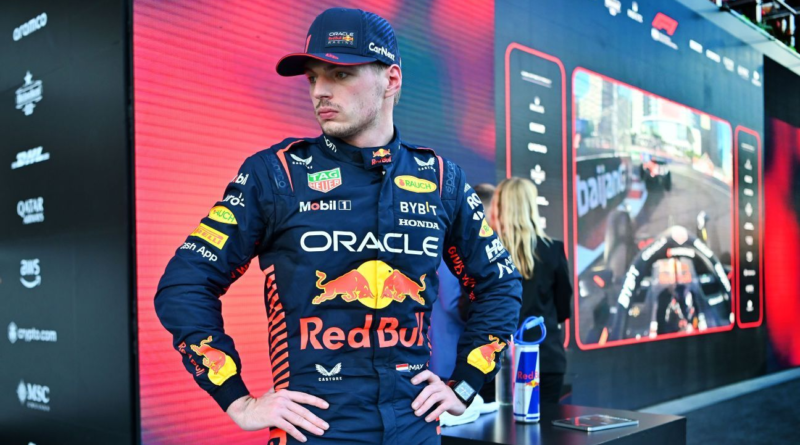'Just scrap the whole thing': Is Max Verstappen right, or did F1's sprint experiment pay off?
BAKU, Azerbaijan — Change is rarely universally popular in any walk of life, so it was no surprise to see a mixed reaction to Formula One’s new sprint format on Saturday. The vast majority of the drivers seemed happy with the new format as long as it remains at a select number of events, but there was one very vocal opponent.
“Just scrap the whole thing,” said world champion Max Verstappen. “I think it’s just important to go back to what we had and make sure every team can fight for the win.
“That’s what we have to try and aim for and implement all these kinds of artificial excitement, I would say. I got bored through today’s qualifying, to be honest.
“I like to have one particular qualifying where you put everything in it, and that was yesterday, which I of course enjoyed. Then you have to do it again today and I’m like, ‘My god, another qualifying?’ I just don’t really enjoy that.”
Sprint races were introduced to the sport during the 2021 season as a way of adding an additional competitive session — in the form of a 100km race — between qualifying and the grand prix. Under the initial set of rules, the starting order for the sprint was decided by Friday’s qualifying and the finishing order of the sprint then determined the grid for the grand prix.
In 2022 a minor change was made when points were extended from the top three finishers to the top eight, but this year the format has been overhauled with the 100km race no longer setting the grid for the grand prix, which is instead decided by Friday qualifying. The sprint race now sits as a completely separate race on Saturday, with its own qualifying session also taking place earlier in the day to set the grid.
Compared to a traditional weekend of Friday practice, Saturday qualifying and a grand prix on Sunday, the latest sprint format swaps two practice sessions for two additional competitive sessions. It is the main argument for having sprint races and one that is hard to counter when it comes to adding value for fans at the track and watching from home.
But the new format makes for an unusual feel to the weekend. Essentially, the traditional F1 format has been boiled down to two days, playing out on Friday and Sunday, while the sprint element sits in the middle as a separate entity. It means there are two very similar qualifying sessions on consecutive days (the timings of Saturday’s sprint shootout are slightly shorter eliminating a return to the pits between timed laps) and two races (albeit one a third of the length of the other) also on consecutive days.
“I think it’s OK,” said Fernando Alonso. “Obviously, I like the idea to have less practice and the fans for sure will like to see more action.
“The only open point for me, felt this morning the qualifying was, I don’t know, a little bit repetitive of what we had yesterday.
“More or less the same cars went through Q1, Q2, only Alex [Albon] and George [Russell] instead of [Yuki] Tsunoda and some others.
“The rest was very similar and we can maybe spice up a little bit more things, in Saturday’s qualifying. Easy to say but then the teams will never agree to spice too many things so I think we have to try and trust and listen to the fans if they really like it and try to help.”
Asked how he would spice things up Alonso, who finished sixth, joked: “Red Bull starting last!”
Which actually feeds into Verstappen’s main point. If the racing was more competitive between teams, as it was in 2021 when Verstappen and Lewis Hamilton went head to head for the title, there would be less of an incentive to tinker with the formula.
“It’s not proper racing, more gambling. I think I’ll have more success in Vegas if I go to the casino,” Verstappen said. “So, yeah, I like racing, I’m a pure racer, I think this is more for the show and, of course, it is important to have entertainment, but I think if all the cars are closer you create anyway better entertainment than trying to do it like this.
“It feels like you have a football match, it’s 3-0 for one team and then suddenly you just say, ‘Let’s reset it to 0-0 and go again’. I find it a bit unnecessary, these kinds of things.”
But balancing the performance between teams is already a priority for Formula One via the budget cap and complex aerodynamic testing restrictions, proving just how difficult it is to level the field. Short of introducing a single-make formula or regulations that significantly limit or eliminate freedom of development, there will always be differences between teams — which, of course, is part of F1’s appeal.
Really, the success of the sprint race, which will be rolled out at six rounds this year, is a different argument altogether and one that has to be viewed in the context of its alternative: 23 races of a traditional weekend with three noncompetitive practice sessions, one qualifying and one race.
“I think it [the sprint format] makes it more entertaining,” Mercedes team boss Toto Wolff said. “We have seen safety cars, and even red flags create some entertainment.
“They need to be handled with care because this sport should never become a circus, but I think we need to calibrate ourselves well. A street circuit, I think, gives more opportunities in a sprint race than if you had it in another one.
“It’s too short to really play strategies. It’s too short that the tyres give up. I’m fine [with it]. But we need to assess the whole weekend on Sunday night and the following days. Is the format good? Do we need to change it here and there to extract the best show?”
Limiting practice also gives teams less of a chance to perfect their car setup during practice. Having just one session puts pressure on teams and drivers to make decisions, and as soon as something goes wrong that pressure ratchets up.
In Baku, Alpine opted to sacrifice Esteban Ocon’s 12th place and 13th place on the two grids because his car’s setup was so bad it was more logical to break parc ferme regulations and take the penalty of a pit lane start. Limited track time for Ocon and teammate Pierre Gasly in the only practice session meant the team was going blind into qualifying when the setup is locked in place to stop teams turning up with two versions of the same car for qualifying and the race.
“It’s the pressure, especially for the top teams it can only go wrong for you,” Saturday’s sprint race winner Sergio Perez said. “Just making a mistake can be extremely costly through the weekend, especially if you make it in FP1, especially here [in Baku] where there’s no room for errors.”
But clearly there are areas where the format can still be improved. The rule that dictates drivers must use a new set of soft tyres in the final session of the sprint shootout meant Lando Norris could not take part in SQ3 on Saturday because he had already used all of his soft tyre allocation on Friday.
What would Ferrari driver Charles Leclerc change? “Maybe the rule of the new soft in SQ3, to be able to at least use a used soft – it’s a shame not to see Lando drive as he didn’t have a set of tyres.”
The timings of the sessions during the weekend could also be refined. There were four hours between the sprint shootout and the sprint race, ostensibly allowing for repairs if needed and accommodating one of the Formula 2 support races in between. But the long gap led some drivers to wonder if the entire F1 weekend could be compressed further.
“I generally like the format,” Lewis Hamilton said. “But there is a lot of time wasted in the weekend, so I think we could do it in a shorter amount of days. I think you could still do three days, but the teams get here Monday or Tuesday, I got here Wednesday like you guys [the media], and there are four hours’ waiting between sessions today.
“Today we could have done at least three sessions. We can do three sessions each day, there is so much time during this day. But I don’t know if that’s possible with the other formulas going on.”
Although the format changes received unanimous agreement ahead of the race weekend, Wolff pointed out there is still the opportunity to refine them further or go back.
“We can always change it. There’s at least ten more stupid things Formula One has done in the time I’ve been here, with former changes. It’s worth considering when it works or not.
“The risk is always confusion for the fans — other sessions at the right time, are we over-saturating with too many races? Are we undermining the grand prix?
“On the other side, we put more spectacle on for the promoter and for the live audiences here on Friday and on Saturday. That’s an advantage.
“You’re going to have more audiences over TV, as there’s two races. Races are important commercially as well. And if it’s entertaining then we should do it.
“But it’s not an easy call. It’s good we all agreed to do it, to analyse what is positive and what is negative.”




